 Welcome to the Computer Vision and Multimedia Lab website.
Welcome to the Computer Vision and Multimedia Lab website.
GET IN TOUCH
Virtual reconstruction of the Ark of St. Augustine / Ricostruzione virtuale dell'Arca di Sant'Agostino
The proposed case-study is the 3D modeling of an articulated sculpture dated 1362, the Ark of St. Augustine, located in Pavia in the church of San Pietro in Ciel d’Oro. The bilingual volume (Italian and English) "The Ark of St. Augustine. Student participation in the use of digital technologies for innovative interpretations of art", edited by Virginio Cantoni, Mauro Mosconi and Alessandra Setti, printed in December 2022 (PSYCOMIX, ISBN: 978-88-9465-261-1) describes in details the project, with richness of information and images.
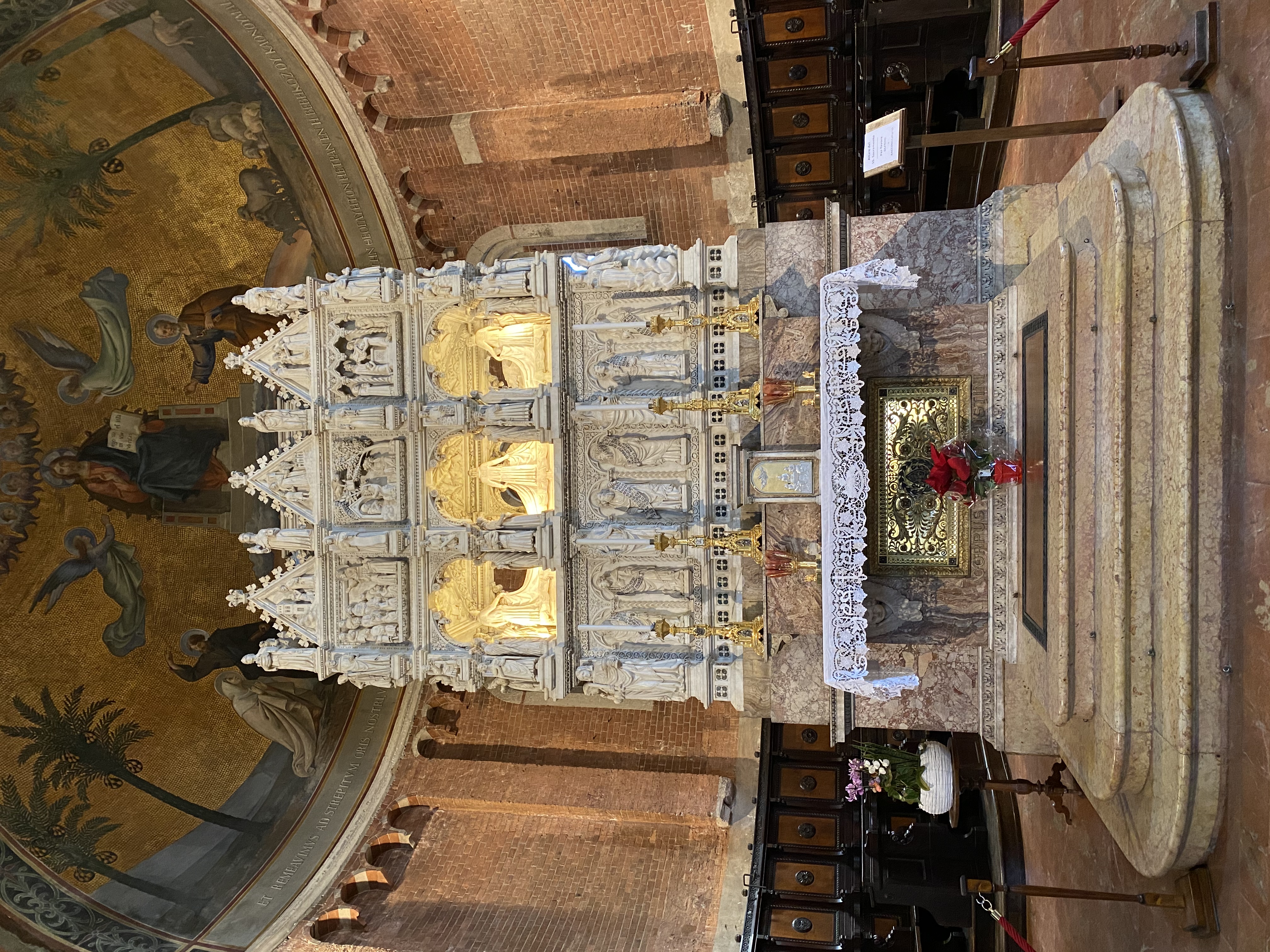 The Ark, (here depicted in four engravings by the Ferreri brothers - 1832) is a Gothic sculpture in white Carrara marble, containing the remains of St. Augustine from Ippona. It was originally conceived as single artefact viewable on all four sides, but its current location, high above the altar, makes difficult to observe it.
It has three narrative registers that identify four orders or horizontal levels (reference CURIOSITÀ DI PAVIA E DINTORNI - L'ARCA DI SANT'AGOSTINO, website by Gianni Cattagni):
The Ark, (here depicted in four engravings by the Ferreri brothers - 1832) is a Gothic sculpture in white Carrara marble, containing the remains of St. Augustine from Ippona. It was originally conceived as single artefact viewable on all four sides, but its current location, high above the altar, makes difficult to observe it.
It has three narrative registers that identify four orders or horizontal levels (reference CURIOSITÀ DI PAVIA E DINTORNI - L'ARCA DI SANT'AGOSTINO, website by Gianni Cattagni):
> the lower register (FIRST ORDER), which contains the sarcophagus, represents the statues of apostles alternating with those of evangelists, saints and virtues;
> the middle register (SECOND ORDER) is made of columns with statues of saints, popes and bishops; inside, above the sarcophagus, the statue of St. Augustine, with an open book in his hands, is lying on a sheet held up by six deacons, and surrounded by Doctors of the Church. The vaulted ceiling of this middle part is made of hundreds of seraphim, busts of saints, the archangels Raphael and Michael and, in the center, Christ the Redeemer;
> the upper register shows nine episodes from the life of the saint (THIRD ORDER), crowned at the top by his miracles represented in ten triangular tympana alternating with angelic figures (FOURTH ORDER).
The Ark is made up of 95 statues and 50 bas-reliefs with various scenes, for a total of over 400 items (statues, vegetation, objects, animals and schematic representations of cities - here an example). The overall size is: 307 cm x 168 cm x 393 cm.
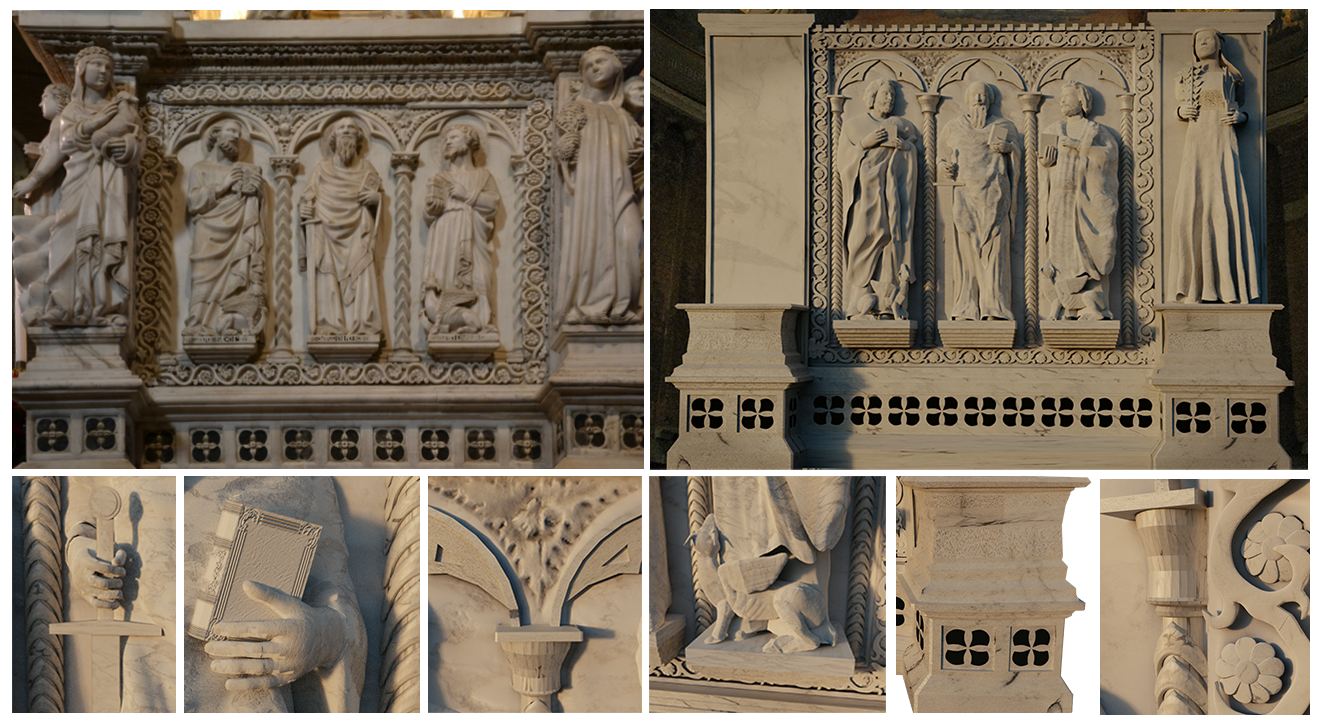
3D Modeling
3D models have been made by the students of the "Computer Vision" course of the Master's Degree in Computer Engineering of the University of Pavia - academic years 2017/2018, 2018/2019, and 2019/2020 - under the supervision of prof. Virginio Cantoni.
The integration of the components in the respective architectural structure, with all its elements, is shown in four videos made by:
> Deborah Tandurella for the FIRST ORDER,
> Alessio Gullotti for the SECOND ORDER,
> Giovanni Maria Levantino and Andrea Pompa for the THIRD ORDER,
> Luigi Zaccaria Del Pio for the FOURTH ORDER.
The video "3D modeling of the Ark of St. Augustine", made with the contribution of the Vector team (grouping some alumni), shows a 360-degree view of the funeral monument as a whole.
The 3D model of each item (statues, scenes and architectural elements) are introduced below. The complexity of the 3D reproduction of this sculpture is partly reduced by the only used material (without transparency, with reduced diffraction, fixed diffusion and essential optics) and by the simplification in lighting management, which can be limited to the environmental one.
The names of the students/s, associated to the realized 3D model/s, are listed in a webpage dedicated to the individual contributions.
FIRST ORDER: statues of virtues separate bas-reliefs representing apostles and saints.
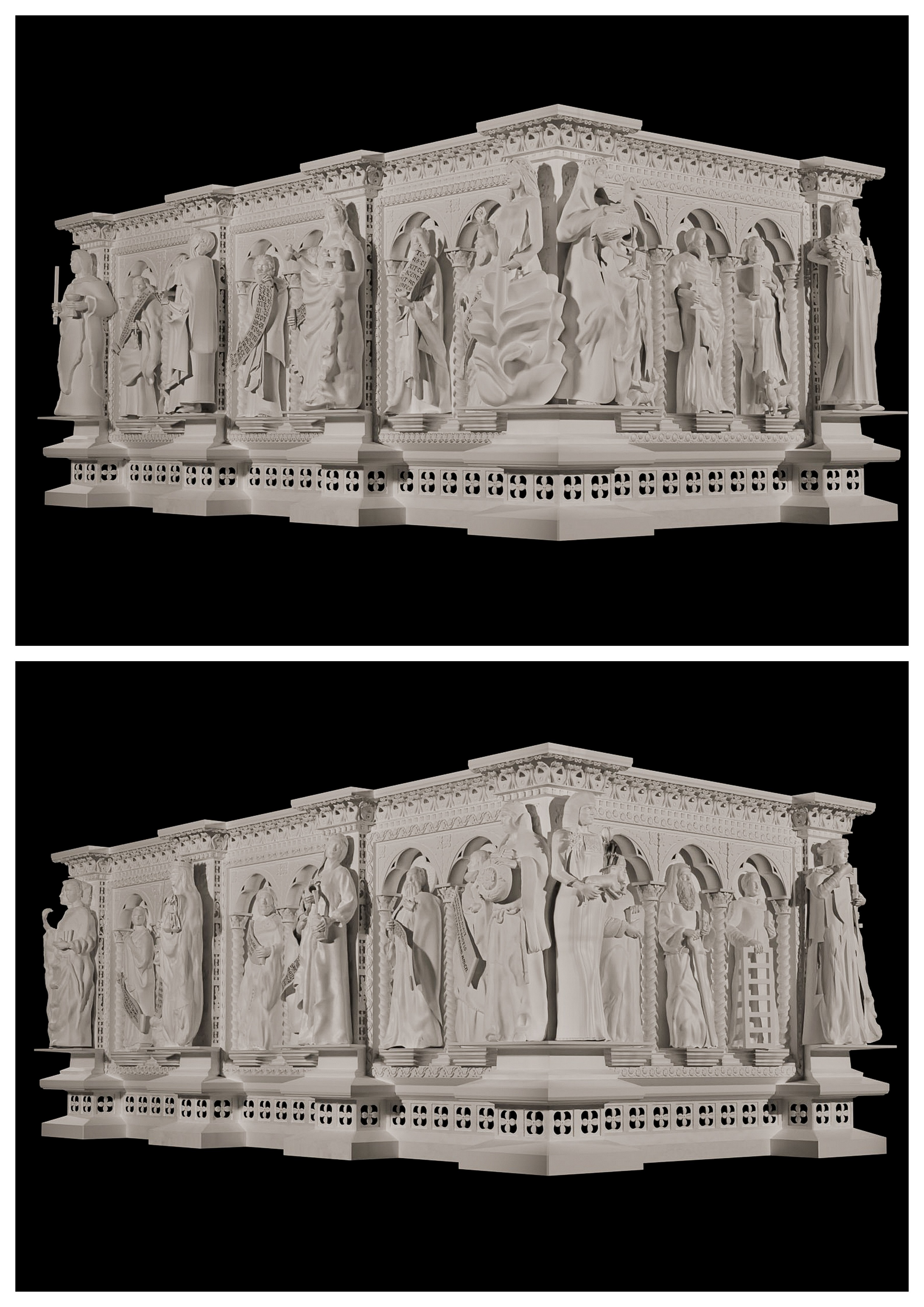 Front side: four pillars are decorated with the three theological virtues (Faith, Hope, and Charity) and Religion. From left, between Faith and Hope, there are the apostles St. Peter and St. John; between Hope and Charity, there are the apostles St. James and St. Andrew; between Charity and Religion, there are the apostles Thomas and Bartholomew.
Front side: four pillars are decorated with the three theological virtues (Faith, Hope, and Charity) and Religion. From left, between Faith and Hope, there are the apostles St. Peter and St. John; between Hope and Charity, there are the apostles St. James and St. Andrew; between Charity and Religion, there are the apostles Thomas and Bartholomew.Rear side: four pillars are decorated with the four cardinal virtues (Prudence, Justice, Temperance, and Fortitude). From left, between Prudence and Justice, there are the apostles Philip and Matthew; between Justice and Temperance, there are the apostles James of Alphaeus and Simon; between Temperance and Fortitude, there are the apostles Thaddeus and Matthias.
Short left side: the pillars are decorated with Chastity and Obedience. Between Chastity and Obedience there are St. Stephen, Paul the Hermit, and St. Lawrence.
Short right side: the pillars are decorated with Meekness and Poverty. Between Meekness and Poverty there are the evangelist Mark, St. Paul, and the evangelist Luke.
SECOND ORDER: Statues of saints, bishops and friars are located outside. Inside the small temple, statues of different figures assist Augustine on his deathbed. The upper part is a vaulted ceiling, enriched with representations of seraphim, archangels, saints, prophets and Christ the Redeemer.
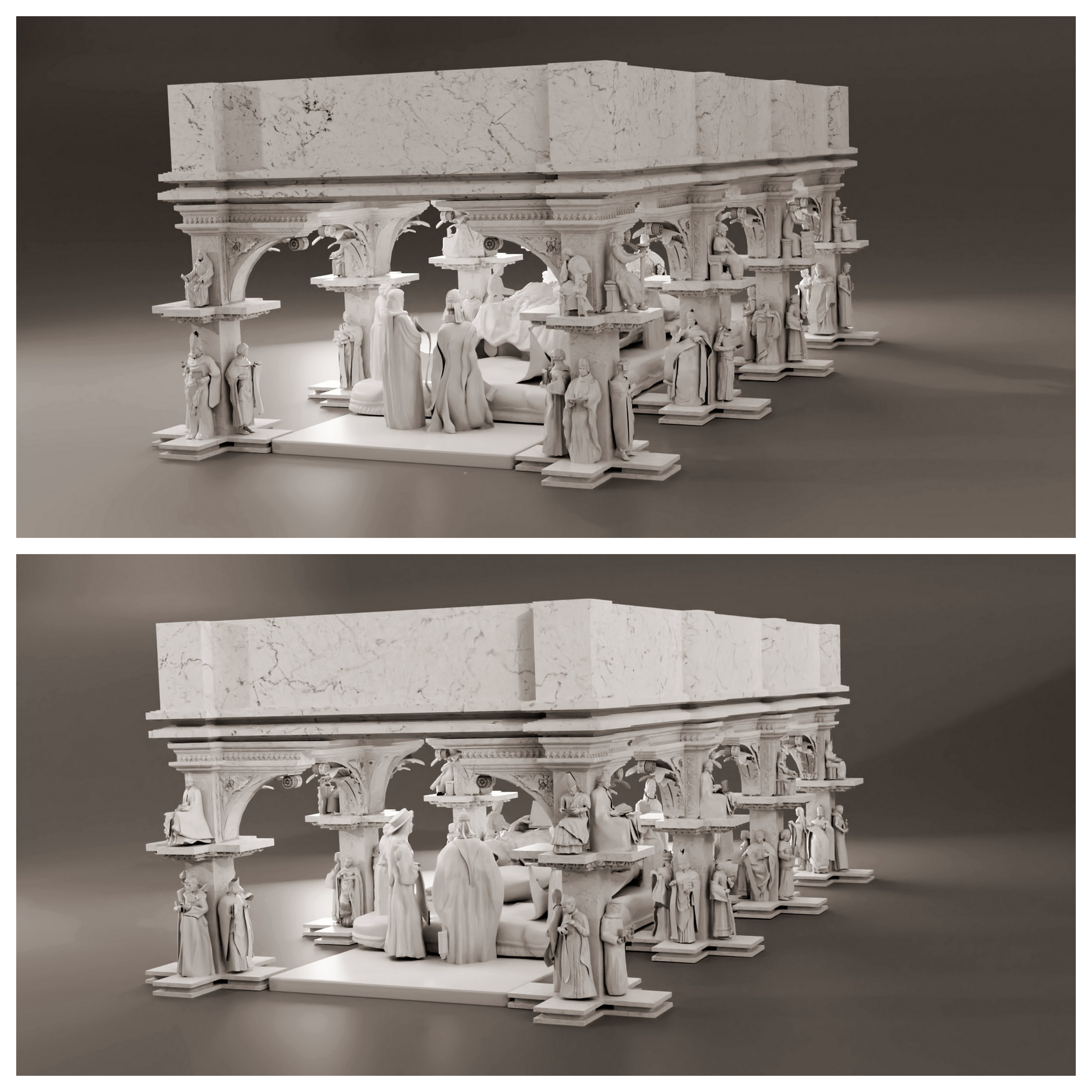 Front side: statues of friars and bishops, sitting in the upper part and standing in the lower part, decorate the four small pillars. In the upper part, there are three of the four crowned saints: Claudius, Nicostratus, Sinforiano. Simplicio replace the fourth, the missing one, Castorio.
Front side: statues of friars and bishops, sitting in the upper part and standing in the lower part, decorate the four small pillars. In the upper part, there are three of the four crowned saints: Claudius, Nicostratus, Sinforiano. Simplicio replace the fourth, the missing one, Castorio.Rear side: statues of friars and bishops, sitting in the upper part and standing in the lower part, decorate the four small pillars.
Short left side and short right side: statues of friars and bishops, sitting in the upper part and standing in the lower part, decorate the pillars.
Inside the temple: the statue of St. Augustine, dressed in papal clothing, lies inside. Standing at the four corners there are statues of St. Gerolamo, St. Gregory the Great, St. Ambrose and St. Simpliciano. Three deacons on each side lift with their hands the veil of St. Augustine.
Internal vault: the upper internal part is a vault, made up of many characters (including seraphim, archangels, saints, and prophets), facing the scene below and the statue of St. Augustine. At the center of the vault is the figure of Christ the Redeemer, which emerges from the vault itself. Enclosed in an almond, it is surrounded by eight seraphim. The rectangular surface of the vault is divided by two long paths containing other seraphim that follow the diagonals of its shape, to disappear in the central part under the almond. The two side parts are in turn divided in two, separating the figures contained. To the left are represented the archangel Michael and two saints; to the right, the archangel Raphael supporting the little Tobias, with a dog and a fish, Lazarus and Magdalene; in the right side of the Redeemer there are representations of female figures (St. Catherine of Alexandria and St. Lucy), with the Virgin Mary in the center, while in the left side there are representatons of male figures (Isaiah and Jeremiah), with St. John the Baptist in the center.
THIRD ORDER: twelve statues of Augustinian friars adorn twelve small pillars and, between them, bas-reliefs represent scenes of Augustine's life.
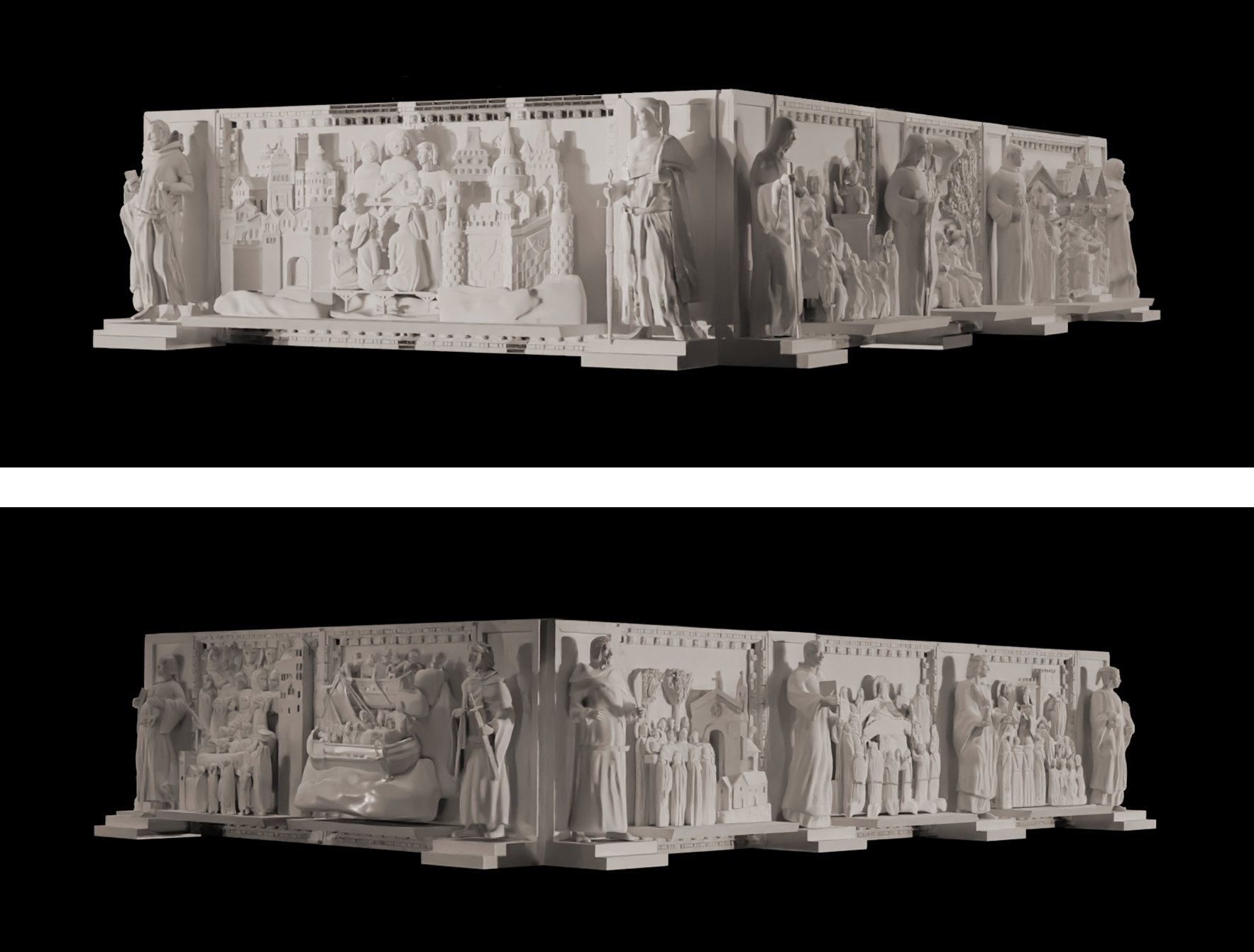 Front side: four statues of Augustinian friars and three bas-reliefs. From left, Augustine listens to a sermon by St. Ambrose, who speaks from the pulpit; in the second bas-relief, Augustine and Simpliciano dialogue with each other and on the right side is represented the scene of “Tolle lege” (“Take, read”), where an angel hands an open book to Augustine; in the third bas-relief Augustine is kneeling at an octagonal baptismal font while receiving the habit of a catechumen by Ambrose.
Front side: four statues of Augustinian friars and three bas-reliefs. From left, Augustine listens to a sermon by St. Ambrose, who speaks from the pulpit; in the second bas-relief, Augustine and Simpliciano dialogue with each other and on the right side is represented the scene of “Tolle lege” (“Take, read”), where an angel hands an open book to Augustine; in the third bas-relief Augustine is kneeling at an octagonal baptismal font while receiving the habit of a catechumen by Ambrose.Rear side: four statues of Augustinian friars and three bas-reliefs. The first one from left represents the funeral of St. Monica, mother of Augustine, at the church of Ostia; the second one depicts the institution of the Augustinian Order; in the third bas-relief two scenes are shown, on the left Augustine refutes an interlocutor, while on the right he gives a baptism.
Short left side: two statues of Augustinian friars and between them a bas-relief representing Augustine in the act of preaching, in Rome and Milan.
Short right side: two statues of Augustinian friars and between them a bas-relief divided into two panels: in the left panel, in the lower part, the Lombard king Liutprand carries the body of Augustine to the gates of Pavia, while in the upper part it is shown the entrance of Augustine's body in the basilica of San Pietro in Ciel d'Oro. The right panel, also divided into two scenes, shows in the upper part Liutprand and an Augustinian friar landing in Sardinia, while in the lower part the same boat is represented, sailing from Sardinia with the body of Augustine in the center, the bishop of Pavia Peter in front and King Liutprand behind, pointing the way with his index finger.
FOURTH ORDER: eight statues represent the celestial hierarchies while ten tympana contain scenes of Augustine, saint, after his death.
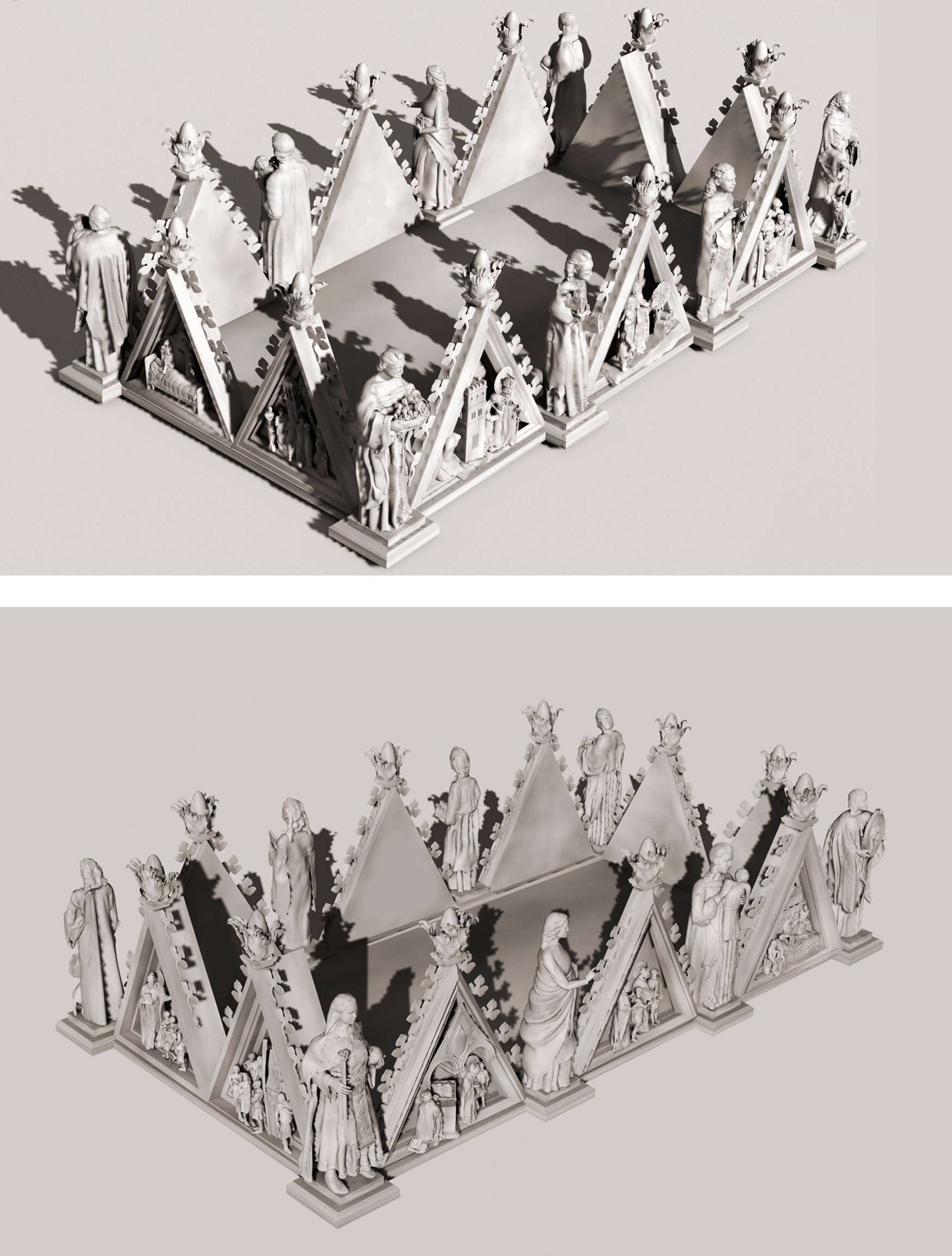 Front side: from left, the celestial hierarchies Angel, Principality, Virtue and Authority; in the first tympanum, Augustine frees a man from prison; in the second one, Augustine leads the man of the previous panel to quench his thirst at the river; in the third tympanum, Augustine blesses a woman on her knees, possessed by the devil.
Front side: from left, the celestial hierarchies Angel, Principality, Virtue and Authority; in the first tympanum, Augustine frees a man from prison; in the second one, Augustine leads the man of the previous panel to quench his thirst at the river; in the third tympanum, Augustine blesses a woman on her knees, possessed by the devil.Rear side: the celestial hierarchies Domination, Cherub, Archangel and Throne; in the first tympanum from left, Augustine on his knees prays at an altar, and Augustine shows an open book to a man with beard and claw feet (like the devil); in the second tympanum, Augustine is represented twice, while converting two heretics with claw feet; in the third tympanum, Augustine is on his deathbed, with an open book, while blessing with his right hand, with the city of Hippo in the background.
Short left side: in the first tympanum from left, Augustine is at the bed of a sick person (this is probably the scene of the Knight of Hippo healing) and there are two dogs under the bed; in the right tympanum, a visit to the basilica of San Pietro in Ciel d’Oro by an illustrious person (perhaps Egelnoto of Canterbury, who obtained a relic of the saint in 1022).
Short right side: in the first tympanum from left, Augustine comforts some infirm with crutches; in the right tympanum, Augustine appears to some pilgrims who enter the basilica of San Pietro in Ciel d’Oro.